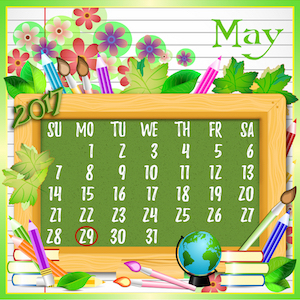Seasonal Teacher Fatigue: Regroup & Recharge!
 By Elyse S. Scott
By Elyse S. Scott
Much to my adolescent granddaughter’s chagrin, I always ask her how school is going. Though retired now for five years from a long career in the middle, I stay current by using her as a resource about teaching and the work she’s assigned.
She’s a good student, tries hard, but like her mother before her she chafes at the constrictions associated with all things “school.” Last weekend when I asked my usual questions, she responded in a quick adolescent rant that I will translate into “educationally correct” terms.
Basically she told me that her teachers were losing their edge, they weren’t doing much of anything that seemed relevant to her, and while some teachers previously had been lots of fun, things were going south – becoming lackluster and boring. Some classes were out of control, and teachers she formerly liked had become inconsistent and apathetic.
Countering the “black hole” of exhaustion

However, we owe our students more than that, and I am here to say, we owe ourselves more than that since we have an expanse of time that is a gift that should not be squandered. Clearly there were times in my teaching life when I felt this way, but having written two books now on middle level education, I’ve had the chance to reflect on some of the strategies that always helped me regroup and get back on track.
Before the regrouping process can take place, teachers first must forgive themselves if they have hit this wall. No teacher is superhuman, and the incredible demands of teaching today – coupled with adolescent charges who find electronics, personal drama, and, at this time of year, spring fever more enthralling than a lesson on polygons – can be pretty overwhelming.
But the important work of school continues, and we must recharge or give in to defeat. So what are some helpful suggestions to end the slump and get back on track?
Strategies to try now
♦ Self-reflect. This is a process I have used all year long, at the end of each teaching week, over vacations, and especially on spring break. It includes asking questions like
- What teaching and learning episodes have satisfied me most?
- What have been my biggest challenges?
- When were my students most engaged and contributing?
- What brought me great joy? And most important:
- What would I do differently?
An effective teacher is always rethinking, tweaking, fixing, and modifying. These questions remind us that we must enjoy the materials we use, plan engaging lessons, and elicit student voice because enthusiasm breeds the same in our students.
At the same time we have to address the challenges of unwelcome behaviors, remembering to pick our battles without throwing up our hands or wishing days away – striving instead to get back to consistency of discipline when we feel it slipping.
♦ Go back to basics. Educators know the essential elements of good teaching practice, but even the best get mired in the day-to-day grind and need to “meditate” on what I call the paradoxes embedded in the middle. We must project energy even when the stores of dynamism are depleted. Positive energy begets positive energy. Though we tend to think that adolescents are free spirits and love to go solo, they are not mind readers. Only with structure, clearly defined guidelines, and a teacher fully vested in the role of facilitator can they discover, create and fly!
We must remember the cardinal rule of any middle school classroom: because adolescents bore easily, we must make Herculean efforts to vary instructional strategies. Picture a toolbox: no one tool does it all, even technological tools. Sameness is the bane of adolescents; a delicate balance of relevant curriculum, varied instructional strategies and activities, and tapping adolescent interest is required.
♦ Overplan. Effective teachers are proactive rather than reactive. I always found that intense planning and organization would ward off all kinds of problems in the classroom. Bring back the fun by saving a unit or project that you know is a winner for the lean times. Put students in charge with an inquiry-based project that promotes excitement as well as ownership. And avoid downtime: maximized use of class time results in far fewer problems for everyone in the room.
♦ Keep your own counsel. Do you try to avoid the faculty room when morale is ebbing or the atmosphere is particularly negative? A colleague of mine would always say, “Misery is optional!” Sometimes it was very helpful to recall my personal vision of my role as teacher and what kind of place I wanted my classroom to be.
I’ve always used a mental checklist to guide me through the rough spots and assess how my “visions” are holding up. In the classroom, I always wanted to make learning interesting and relevant; find exciting, inspirational materials; reach all students including the reluctant, challenged learners; and above all connect with adolescents and their world.
Always a work in progress
As a writer, I always go back to my own personal experiences in education. I believe that even those people closest to me never really knew “the essence” of my teaching. Yes, they saw the hard work, the stress and the passion, but I don’t think most people understand what it takes to be a highly effective teacher, day in and day out – what it takes for students and their teacher to truly connect, each day, every day, and what’s needed to have deep learning take place.
The most important thing to remember when we feel we are losing “it,” or our students, is that teaching is always a work in progress for newbies and veterans alike. Effective teachers continuously perfect their craft, learn from their mistakes, and do not fear change. The “black holes” will always be there and wishing that our students were more cooperative, more well-behaved, and a little less self-centered will not make it so. They are adolescents after all!
It all comes back to a philosophy developed from much soul searching and reinvention – a philosophy I know I share with many successful educators in the middle: Do what’s right for kids.
________________________
Elyse S. Scott is the author of Secrets From the Middle: Making Who You Are Work For You and Awakening the Middle School Voice: ‘Engineering’ the Language Arts To Excite Adolescents (both from AMLE). She is a retired English teacher who began her career teaching at the community college level but found her true passion teaching eighth grade for 30 years. She now writes, lectures, and consults in the Hudson Valley of New York. You can reach her at retirednysteacher@gmail.com.



































Elyse Scott’s advice is spot on! She inspires all teachers to successfully find the renewed energy to sprint into that ” last lap” of the school year. Thank you, Elyse!